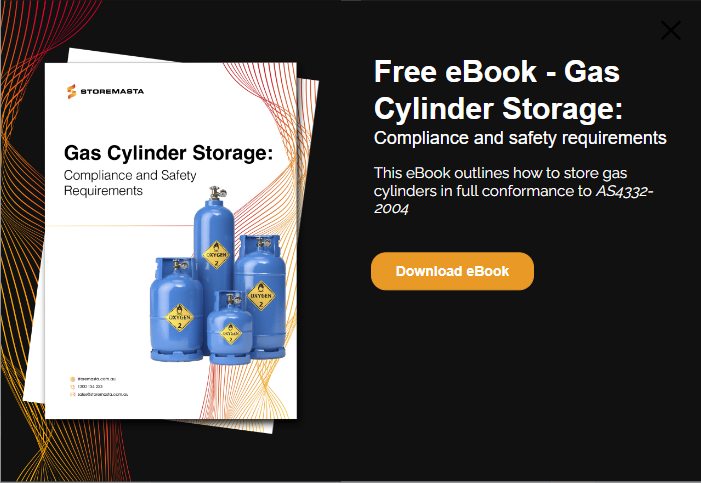Three workers were dismantling steel framework at height when they accidentally dropped a heavy steel bracket. The bracket landed on an acetylene cylinder below which was stored incorrectly. The cylinder was unrestrained, and when hit by the bracket was punctured and instantaneously caught fire. The cylinder on fire then impinged an adjacent acetylene cylinder (also unrestrained) causing it to explode. All three workers were seriously burned and hospitalised from the fire and explosion.
What is acetylene gas?
Acetylene is one of the world’s most widely used fuel gases. Acetylene has the highest flame temperature of any of the fuel gases and mixed with oxygen is the only one capable of welding steel. Unlike many other flammable gases though, acetylene is actually lighter than air so it doesn’t accumulate in low lying areas causing asphyxiation hazards. This makes it popular for use in underground operations and workplaces.
Why are acetylene cylinders different?
Acetylene is an extremely volatile gas which has a high risk of a dangerous chemical reaction called decomposition. Decomposition is a spontaneous reaction that can cause high energy explosions. To stabilise the gas against decomposition, acetylene is never stored in a pure state. Instead it is mixed with a liquid solvent (usually acetone) and stored in a special cylinder which contains a porous filler material (also known as a porous mass).
The liquid acetone is absorbed by the porous filler material which also serves to slow down or halt any decomposition reactions. Decomposition can be caused by a flashback, acetylene cylinders being dropped, or exposure to heat/fire. It is critical that these specifically designed cylinders are stored and handled with extreme care.
How to store acetylene gas cylinders
Store acetylene cylinders upright
According to AS4332-2004 - The storage and handling of gases in cylinders, all gas cylinders must be stored in an upright position and secured with safety chains or other secure restraints. It is especially important for acetylene cylinders to be stored upright to prevent the gas separating from the acetone. This is so critical cylinders should be allowed to rest for at least for 1-2 hours if they have been moved about in the workplace or just received from the supplier.
Locate acetylene cylinder stores away from ignition sources
Acetylene is so volatile you can expect that ANY leak at all will result in a fire. So it’s essential that the cylinders are stored with their valves closed, attachments removed and cylinder caps in place. Because acetylene can ignite from even the smallest amount of static electricity cylinder stores must be located away from any possible ignition sources.
Ensuring your cylinder stores are not exposed to ignition sources including static electricity will require a thorough risk assessment. Your risk assessment may include the following considerations:
- Are naked flames used anywhere near cylinders stores? This could include flames from cigarette lighters, matches, bunsen burners, spirit lamps, candles, and pilot lights.
- Could static electricity be discharged near cylinder stores? This could originate from mobile phones, keyless remotes, thermostats, friction from clothing and fabrics, brush discharges.
- What other hot works are conducted onsite and are they carried out near cylinder stores? Hot works include things like welding, soldering, brazing, burning, heating, torch cutting.
- Are cylinder stores located near any sources of industrial heat? Heat can be generated by radiators, boilers, steam pipes, furnaces, and overheated machinery.
- What about production or maintenance operations that create sparks? Are cylinders stored near workers using grinders, industrial cutters, or exposed to sparks from vehicular impact and machinery friction?
- Assess the risk of electrical equipment including light fittings. Sparks and fires can be created by overloaded extension cables, power-boards and circuits; exposed wiring; and faulty equipment — are your cylinder stores vulnerable to any of these?
- If your acetylene cylinder stores are outside, are they exposed to natural ignition sources such as lightning or direct sunlight?
- Are combustible materials including vegetation and refuse located within 3 metres of acetylene cylinder stores?
Secure acetylene cylinders in a gas bottle cage
Because even rough handling of acetylene cylinders can result in a delayed explosion, it is essential that storage facilities secure them from falling over; being dropped; impacted by forklifts and falling objects; or able to strike one another.
The best place to store the cylinders is in a sturdy gas bottle cage that protects the cylinders from impact. The store must also be clearly marked with compliant warning signs and placards as well as fenced or locked to prevent untrained and unauthorised personnel from accessing the cylinders.
TIP: Read our companion article What are Class 2.1 Flammable Gases? which looks the risks flammable gases present to people, property and the environment; and how to store them legally and safely.
Next steps
Safely storage acetylene and other gas cylinders is a must and adherence to the Australian Standard AS4332 is a critical component of ensuring your compliance with WHS legislation. To understand the complete legal requirements for storing compressed gases, why not download our free eBook Gas cylinder storage: Compliance and safety requirements. It is FREE and will help you meet your WHS obligations. Click on the image below to get started.
Joining the team as a Dangerous Goods Storage Consultant, Melissa Hampton became Storemasta's Marketing Manager in late 2021. With extensive knowledge and experience in chemical compliance, Melissa is responsible for leading the Marketing team and helping shape their marketing strategy. In her spare time, you can find Melissa hiking, swimming and enjoying the great outdoors in beautiful north-west Tasmania.
